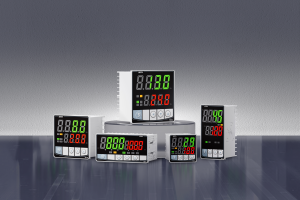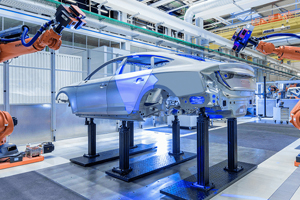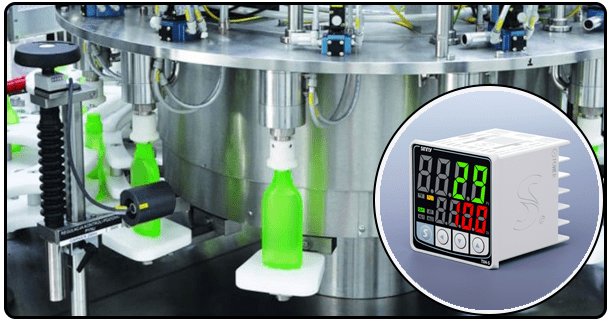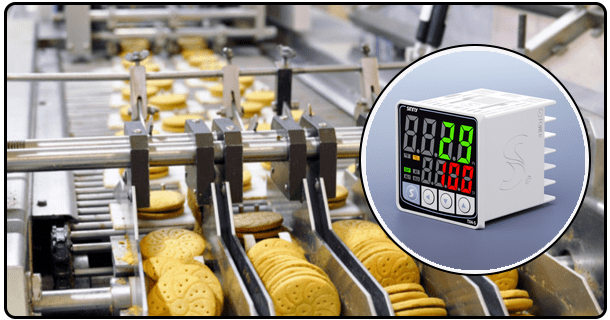A simple way to improve precision for every application
1. Introduction: Simplifying precision temperature control
The regulation of temperature is essential in a wide range of applications and industries, from home comfort to precision scientific research or the harsh conditions of manufacturing. It is important to maintain specific temperatures, not only for efficiency, but also for product quality and reproducible results. This level of control is traditionally achieved by carefully integrating a temperature sensing unit, an advanced controller that executes a PID algorithm and a control actuator. While powerful, this setup can be a challenge due to the complexity of wiring, installation, and human error.
Pre-wired PID controllers are a major advancement in thermal control. They allow for a more democratized access to automated, precise temperature management. The controllers combine key components such as the sensor and/or actuator connections into one unified unit. Pre-connecting the components simplifies installation and makes sophisticated PID controls accessible to even users with little technical knowledge. Pre-wired PID Controllers are a popular option for applications that require accurate temperature control. They offer an easy to use combination of reliability, speed, and ease.
2. Understanding the basics: What exactly is a PID controller?
At the core of any effective temperature control system, whether pre-wired or traditionally configured, lies the Proportional-Integral-Derivative (PID) control algorithm. PID is widely regarded as the standard in feedback control. It offers an effective and flexible way to manage processes including temperature. PID is a designation for three mathematical terms which are added together to produce the output control signal. It is important to understand these components in order to fully appreciate how pre-wired controls work.
Proportional (P), Term: This identifier generates a signal output whose magnitude directly relates to the error value. The difference between the setpoint temperature desired and the temperature actually measured by the sensor. Imagine it as an immediate response. The actuator will make a larger adjustment (such as turning the heat up) if the error is greater. A purely proportional reaction can lead to small and persistent errors, which could cause the system not to reach its exact setpoint or even oscillate around it.
Integral (I), Term: This integral term is used to address this persistent error. The integral term calculates cumulative error sums over time, and produces a control out put that will increase (or decrease) for as long as there is an error. The steady state error is slowly eliminated by this term, which pushes the system toward the setpoint. The integral term can be too aggressive and cause the system's temperature to exceed the setpoint.
The derivative (D) term: It focuses on rate of error change. The derivative term calculates the rate of change between the current and previous error. It acts as a damping term, helping to predict future errors by using the current trend. This helps prevent oscillations and overshooting. This improves system stability and responsiveness during sudden changes to load or setpoint.
Combining these terms, Proportional Integral and Derivative, the PID Controller can produce a subtle and effective signal which adapts to system behaviour, bringing the temperature quickly back to desired setpoint, while maintaining stability. The pre-wired control implements this sophisticated logic.
3. Pre-Wired: What is it?
How the actuator and sensor connections are made is a crucial factor in determining how easy it will be to implement. In traditional PID controllers, the user is often required to separate the input signal from the sensor and the output to the cooling or heating element. Multiple wires and terminal blocks are often required, as well as careful attention to wiring colors and polarity. Wiring can present a major obstacle, particularly for those who do not have electrical training or need to quickly deploy several controllers.
This is what the term "prewired" means. This means that some, or all, of the connections in the controller have been integrated. Pre-wiring is most commonly used in the following configurations:
Sensor pre-wired: This configuration comes with the internal connections ready for a certain type and range (e.g. a thermocouple type or RTD type). In most cases, the user only has to attach the probe of the temperature sensor to the input designated on the controller. The user no longer has to worry about the wiring of the sensor to the controller unit.
Pre-Wired Actuator: The controller has connections for specific types of heating and cooling elements (such as a resistive heat source or small chiller). Users connect the actuator directly to output terminals of the controller. It is a simple way to handle one of the more complex aspects of setup.
Pre-wired Sensor and Actuator: Certain pre-wired control modules take this concept a step further, integrating both connections for the sensor and actuator. This creates a self-contained, complete module of control for a sensor-actuator pairing. It offers maximum installation ease.
The controller package is more complete when these connections are included. This reduces the amount of external connections that the user has to manage and create.
4. Choose a pre-wired PID temperature controller for its advantages
Pre-wired PID controllers offer several advantages compared to traditional components-based solutions. This makes them a popular choice for many users.
Time-savings of up to 50%: The most obvious benefit comes from the Da Fu Suo Duan De AnZhuangHe Diao Shi Jian. This is made much easier by pre-wired control panels. Users can often plug in the sensors (if they are not integrated) and connect the power to the controller, which will be ready for the basic configuration. This speeds up deployment.
Simple Setup: Fewer wire connections means fewer chances for wiring mistakes. A miswired system can cause malfunctions, inaccurate temperature readings or damage to equipment. The pre-wired connection, which is standardized in the controller's design, can reduce this risk significantly, resulting in a more predictable and reliable initial operation.
User-Friendliness: This factor is important for users who are not technically minded or when technicians might be in short supply or focused on another task. Pre-wired PID controllers lower the barrier of entry to implement sophisticated PID controls. A simpler configuration interface also makes it easier to use.
Space Efficient: By integrating the actuator and sensor connections in the controller unit, a compact solution can be achieved compared with separate actuator, sensor and controller boxes and their wiring harnesses. It is especially useful in environments with limited space.
Increased Reliability Each connection is a possible failure point. Pre-wired control systems reduce vulnerability by minimizing external connections. Internal connections tend to be more resilient and resistant to interference from the environment or accidental disconnections than external wiring.
Performance Out of the Box: A pre-wired control is usually configured to work optimally as soon as it's powered up and configured. This reduces the need for lengthy tuning.
4. Application where Pre-Wired Controllers are a Hit
These controllers are suitable for many different applications, thanks to their versatility and the benefits they offer in terms of installation.
Home automation: Smart homes can use pre-wired controllers for HVAC zone control, climate control of dedicated rooms, such as music or server rooms, managing energy-intensive appliances, like large refrigerators and heat pumps, or creating wine cellars that require stable temperatures.
Lab and Scientific Use: While complicated lab equipment requires customized solutions, prewired controllers can be used for standard applications such as controlled incubators to control cell or bacteria growth, calibration baths, material testing chambers, or temperature-controlled reaction vessels.
Commercial Kitchens: Pre-wired controllers for PIDs can be used to control the temperature in commercial kitchens. They are ideal when it comes to managing ovens, fryers and warming drawers. These controllers ensure consistency in cooking and efficiency. They are also used in the beverage industry to control fermentation temperatures and maintain the chilled temperature of draft beer dispensers or drink systems.
Processes for Small-Scale Industries: Pre-wired PID Controllers are an easy and cost-effective solution to a variety of non-critical tasks in the industrial sector, including maintaining adhesive temperatures during application, drying of small batches of material, or controlling temperature within reaction vessels.
DIY and Hobbyist Projects Due to their ease of use, pre-wired controllers are a great choice for those involved in scientific experiments, electronic manufacturing (e.g. soldering), and even homebrewing projects that require precise temperature control.
5. Important considerations when selecting a pre-wired PID controller
Pre-wired controls simplify the installation process, but careful selection is necessary to achieve optimal performance.
Accuracy and Temperature Range Requirements The initial step in defining your process is to define the temperature range required (minimum, maximum), and also the accuracy level. Check that the controller can be used within these parameters. Verify the accuracy and resolution specified.
Actuator Power requirements (Voltage/Current). The actuator (heaters, chillers, fans, etc.). The controller output capability must be compatible. Check the current and voltage ratings of the controller. You must make sure that the output terminals of the controller are compatible with the requirements and capabilities of your actuator.
Sensor Type Required: In the event that your controller doesn't come pre-wired with an appropriate sensor for your application (e.g. specific types and ranges of RTD, thermocouples), you must select one. Check that the controller is compatible with the type of input connector (BNC connector or screw terminals), depending on the type of sensor. Sensor response times can also play a role.
Actuator Type Controlled: Check that the pre-wired actuator is compatible with the device to be controlled (e.g. a certain type of heater element, small DC fans, solenoid valves). You may need to use your own actuator. Make sure the output of your controller matches what you require.
Options for the Interface: Think about how you'll configure and monitor your controller. Are you going to use a simple display and push button? Does the application need digital communication to monitor and control remotely (e.g. Modbus, Ethernet/IP or USB) or does it require wireless protocols such as Wi-Fi, Bluetooth or Wi-Fi? Select the controller interface which best fits your infrastructure and needs.
Environmental Criteria: How will the controller installed be? Make sure it is NEMA- or IP-rated to prevent it from being damaged by dust, moisture or any other factors in the environment.
Considerations for budget: The price of pre-wired controllers varies significantly. Although they can save time during installation and reduce errors, their initial costs may be more than the cost of the basic, separate components. Compare the benefits of the future against your budget.
6. Installing and Setting Up the System
Installation of pre-wired PID controls, although simplified, requires strict adherence to manufacturer's instructions and safety guidelines. Typically, the general steps involve:
Safety first: Before beginning any installation, always disconnect the power from all connected devices (sensors and actuators) as well as the controller.
Read your manual: Carefully read through the installation and setup instructions specific to the model you own.
Connect power: Plug the power cable into the input terminals of the controller, making sure the voltage is correct. Check connections twice to ensure they are correct.
Connecting the Sensor: The sensor may not be fully wired in the controller (meaning that you will need to connect a sensor probe), so connect it to the input terminals on the controller. If necessary, select the appropriate sensor type and range via the configuration menu of the controller. This step is not necessary if the sensor has been integrated.
Connect Actuator: If actuators are not pre-wired in the controller (that is, you must connect heating/cooling elements), connect actuators to output terminals on controller. Ensure compatibility with the controller unit in terms of power and type. This step is complete if the actuator has been integrated.
Setpoints, Parameters, and Power On: Turn on the Controller. Set the target temperature using its interface (display buttons computer software or network connection). You can also configure other parameters, such as control mode and PID gain if not already pre-set. Refer to the user manual for detailed configuration instructions.
Check Operation: After configuration, turn on slowly the system. Monitor the temperature display. If the actuator does not respond appropriately to temperature deviations from the setpoint, check if it is working properly. If necessary, adjust parameters to ensure stable control.
Pre-wired PID Controllers, like any other electronic devices, require care to ensure optimal performance and durability.
Pre-Wired Controls: Inspect the pre-wired controllers regularly for signs of damage or dust buildup (ensure adequate ventilation) and loose connections. Clean and keep the surrounding area dry. Check the cables of controllers that have external sensors attached via cables.
Verifying Connections: Although prewiring simplifies the process, it is prudent to periodically check the tightness on sensor and actuator terminals of the controller, particularly after major environmental changes, or when problems arise.
Basic Troubleshooting: Some common problems include: the controller failing to power on, inaccurate temperature readings or a system that oscillates. Checking power connections and verifying the sensor and actuator connection are some of the basic troubleshooting methods. Refer to the manufacturer's instructions for issues relating to sensor accuracy.
When Professional Assistance is Needed: After following the instructions of the manufacturer, performing basic troubleshooting with no success or when the system has critical safety processes and interlocks it's best to call the technical support team or hire a professional technician to diagnose the problem.
IX. Conclusion: A Smarter Choice in PID Control
The pre-wired PID controllers are a major advancement in thermal management. They combine the power of PID with the ease of integration. These controllers offer a simplified solution which reduces the complexity of installation, minimises errors in wiring and speeds up deployment. The ease of installation and use of PIDs makes them accessible to users of all levels, including DIY enthusiasts as well as professional engineers.
Pre-wired PID Controllers are a great choice in many applications. These include home automation, lab research, food services, and industrial processes that require accurate temperature control without complicated setup. Pre-wiring is a great way to achieve reliable thermal control, even though careful selection of the right controller based on your specific needs will always be important. Pre-wired PID controllers are a great choice for anyone looking for a reliable and simple-to-implement PID system. They offer a good balance between performance and functionality, and represent a modern engineering innovation.
- Step-by-Step Guide, PID Tuning, Applications
- Explore the basics of PID Temperature Controllers and how they function























